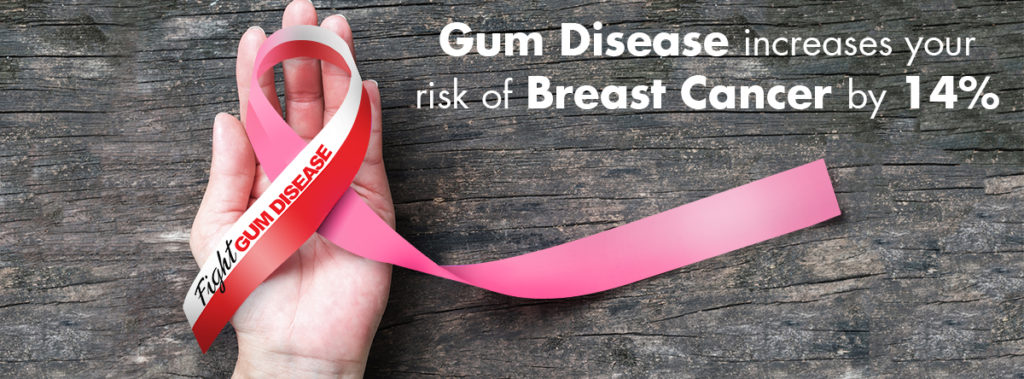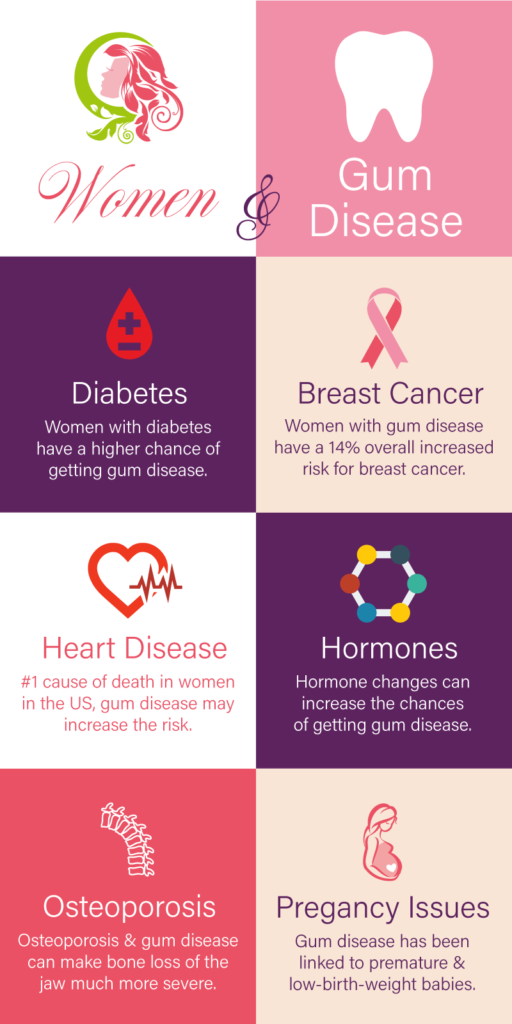 From minor gum irritation to advanced periodontal disease, women’s oral health has been linked to relationships with many other conditions. Share this information about women and gum disease with your mom, grandma, sisters, and friends to help spread the word and increase education about how you can fight gum disease!
From minor gum irritation to advanced periodontal disease, women’s oral health has been linked to relationships with many other conditions. Share this information about women and gum disease with your mom, grandma, sisters, and friends to help spread the word and increase education about how you can fight gum disease!
Hormones Affect Your Gums
Hormone changes affect women’s gums. Starting as early as puberty, hormone changes in progesterone and estrogen increase the amount of blood circulating to the gums, causing an increase in sensitivity that could result in red swollen gums. As they mature, some women have what is called menstruation gingivitis, which has similar symptoms and might also include sores inside their mouth or cheeks. In menopausal and post-menopausal women, gums might also suffer discomfort, and include symptoms like dry mouth, pain, and changes in taste for food (particularly salty, sweet, sour or spicy food). However, each of these examples tends to improve once the hormone levels adjust either naturally or with hormone therapy.
To read more about how hormones affect women’s oral health, please read the American Dental Association’s article here.
More Serious Implications Exist When Periodontal Disease is Confirmed
Perio.org, the website for dental specialists who treat gum disease, reports 38% of women have gum disease. This percentage is not only concerning for women’s periodontal health but also for the connection gum disease has to other serious health conditions. Gum disease has been linked to diseases throughout the body, including breast cancer, diabetes, heart disease, pregnancy complications, and osteoporosis.
Gum Disease and Breast Cancer
 A new study published online in December 2015 for Cancer Epidemiology, Biomarkers & Prevention indicates that postmenopausal women with gum disease were more likely to develop breast cancer than women that didn’t have gum disease. The risk increases if the woman was also a smoker. The researchers garnered their results from a pool of over 73,000 women, 26% (18,980) of which said they had gum disease. Nearly seven years later, over 2,100 of the women with gum disease received a breast cancer diagnosis. Overall, postmenopausal women with gum disease had a 14% higher risk (13.5%) than women who didn’t (12%). Moreover, women with gum disease that were former smokers who quit within the last 20 years had an even higher risk of breast cancer at 36%. Why this is the case is not clear. The lead researcher believes it could be because of the cumulative exposure of breast tissue to periodontal bacteria in the blood stream. Another theory is that inflammation in the gums could affect other conditions. It could also be that these women share other common factors causing them to be more susceptible to breast cancer and gum disease. More research is needed to find a causal relationship.
A new study published online in December 2015 for Cancer Epidemiology, Biomarkers & Prevention indicates that postmenopausal women with gum disease were more likely to develop breast cancer than women that didn’t have gum disease. The risk increases if the woman was also a smoker. The researchers garnered their results from a pool of over 73,000 women, 26% (18,980) of which said they had gum disease. Nearly seven years later, over 2,100 of the women with gum disease received a breast cancer diagnosis. Overall, postmenopausal women with gum disease had a 14% higher risk (13.5%) than women who didn’t (12%). Moreover, women with gum disease that were former smokers who quit within the last 20 years had an even higher risk of breast cancer at 36%. Why this is the case is not clear. The lead researcher believes it could be because of the cumulative exposure of breast tissue to periodontal bacteria in the blood stream. Another theory is that inflammation in the gums could affect other conditions. It could also be that these women share other common factors causing them to be more susceptible to breast cancer and gum disease. More research is needed to find a causal relationship.
To read more about the connection between gum disease and breast cancer, please read the article on Breastcancer.org here.
Gum Disease and Diabetes
In 2012, the American Diabetes Association reported that 29.1 million Americans had diabetes. According to the CDC’s National Diabetes Statistics Report, 2014, 13 million women had diabetes, which breaks down to one in 10 women over the age of 20. Diabetes, the 7th leading cause of death in the U.S. in 2010, is a condition linked to gum disease. Experts agree that people with diabetes have a higher chance of contracting gum disease and suffer more tooth loss as a result of it than people that don’t have diabetes. Gum disease can make the symptoms of diabetes more difficult to control, particularly glucose-level regulation. High glucose levels cause increased complications for both conditions as the high-sugar environment allows the bacteria that cause gum disease to thrive.
Gum Disease and Heart Disease
Heart disease is the number one cause for death of women in the U.S., according to the Heart Foundation. Other studies have revealed a link between gum disease and heart disease. The connection could be the swelling responsible for the hardening of arteries typical of heart disease and the swelling occurring in gingival tissue for gum disease. However, experts do not know if this is a causal relationship. Experts do know that when inflammatory toxins and/or bacteria make their way below a patient’s gum line, it then has access to the rest of the body, including the patient’s heart. While it is true that preventing gum disease will not prevent heart disease, it is also true that better oral health tends to elevate overall health levels. Therefore, the prevailing wisdom dictates that a reduction in any presence of bacteria, like that associated with gum disease, reduces the risk of heart disease.
Gum Disease and Pregnancy Complications
 Researchers have linked periodontitis to a risk for pre-term delivery (PTD) and premature and low-birth-weight (PLBW) babies. Studies indicate that the infection present in the oral cavity gets into the blood stream and can target the fetus. When they cross the placenta, the bacteria create toxicity in the womb and cause early delivery. Both PTD and PLBW infants have higher risks for complications, mental retardation, asthma, upper and lower respiratory infections, ear infections and even death. Many experts agree that women should see their dentists for an oral health evaluation to avoid passing harmful bacteria on to their baby.
Researchers have linked periodontitis to a risk for pre-term delivery (PTD) and premature and low-birth-weight (PLBW) babies. Studies indicate that the infection present in the oral cavity gets into the blood stream and can target the fetus. When they cross the placenta, the bacteria create toxicity in the womb and cause early delivery. Both PTD and PLBW infants have higher risks for complications, mental retardation, asthma, upper and lower respiratory infections, ear infections and even death. Many experts agree that women should see their dentists for an oral health evaluation to avoid passing harmful bacteria on to their baby.
To download the ADA’s patient recommendations for Oral Health during pregnancy, please click here.
Gum Disease and Osteoporosis
Osteoporosis is a bone disease that occurs when the body loses too much bone, makes too little bone, or both. The patient’s bones become fragile and brittle as a result of the loss of tissue, weakening them and causing them to break easily. Osteoporosis is a common condition for women over 50. The National Osteoporosis Foundation estimates nearly 54 million Americans have it or the pre-condition for it (low bone mass), and that one in two women over age 50 will break a bone due to the condition. Researchers have connected osteoporosis to loss of bone in the jaw. This is because osteoporosis working in connection with gum disease will make the bone loss of the mouth much more severe. When the jaw bone deteriorates, the teeth fall out, which is a symptom associated with advanced gum disease.
Taking good care of your teeth and gums is something every woman can do to keep her oral health in tip-top shape. Women should brush and floss every day to remove bacteria that can cause gum disease. Also, women should see their dentists every six months for a complete oral health exam and hygiene appointment. If a woman already has gum disease, then she should undergo treatment promptly. Gum disease is treatable through traditional treatments like surgery or the recently FDA-approved laser treatment called the LANAP® protocol, which is less invasive than surgery and has a much faster recovery time.
In all these connections between gum disease and other diseases, there is no guarantee that eradicating gum disease will reduce the risk of developing the other conditions. However, having gum disease present certainly isn’t helping. Successfully treating gum disease should be a priority not only for a woman’s oral health and indeed, for her overall health as well.

Sources
“Gum Disease and Men.” www.perio.org. Web. 26 September 2016. <https://www.perio.org/consumer/men>
“Statistics About Diabetes.” www.diabetes.org. Web. 26 September 2016. <http://www.diabetes.org/diabetes-basics/statistics/?referrer=https://www.google.com/>
Centers for Disease Control and Prevention (2014). National Diabetes Statistics Report, 2014. Source of data: 2009–2012 National Health and Nutrition Examination Survey.
“Diabetes and Periodontal Disease.” www.webmd.com. Web. 26 September 2016. <http://www.webmd.com/diabetes/periodontal-disease>
“Heart Disease: Scope and Impact.” www.theheartfoundation.com. Web. 24 May 2016. <http://www.theheartfoundation.org/heart-disease-facts/heart-disease-statistics/>
Miller, Kelli. “Periodontal Disease and Heart Health.” www.webmd.com. Web. 24 May 2016. <http://www.webmd.com/heart-disease/features/periodontal-disease-heart-health>
Saini, Raijiv, Santosh Saini, Sugandha r. Saini. J Nat Sci Biol Med. 2010 Jul-Dec; 1(1): 40–42.
doi: 10.4103/0976-9668.71672 “Periodontitis: A risk for delivery of premature labor and low-birth-weight infants.” Web. 26 September 2016. <http://www.ncbi.nlm.nih.gov/pmc/articles/PMC3217279/>
“What is Osteoporosis and What Causes It?” www.nof.org. Web. 26 September 2016. <https://www.nof.org/patients/what-is-osteoporosis/>


Leave a Reply